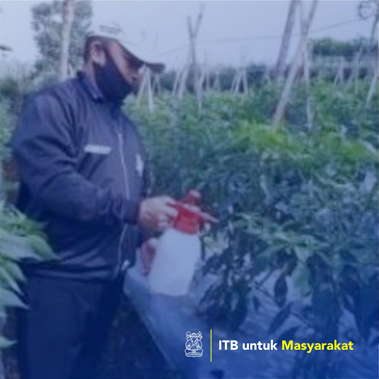

Rika Alfianny
Chili plant (Capsicum annum L.) is one of the leading horticultural commodity products in Indonesia. Based on the Center for Agricultural Data and Information Systems (2019), chili production in Indonesia is 1.26 million tonnes with a harvest area of 144,391 ha and productivity of 8.77 tonnes per ha.1 This productivity is still low when compared to other Southeast Asian countries. This is the result of technical and non-technical constraints on chili cultivation. The technical obstacle in chili cultivation is attack by Plant Pest Organisms. The problem faced by chilli farmers is Anthracnose disease. Anthracnose is one of the main diseases (OPT) that attacks chilies, this disease is caused by the fungus name Colletotrichum capsici. The growth of the fungus is stimulated by humid conditions and relatively high temperatures.2 This disease is causing a decrease in yield also damage the aesthetic value of chilies. The yield loss due to this disease can be up to 100%. Synthetic pesticides has been continuously used to control Anthracnose but not shown satisfactory results. The use of pesticides also have a negative impact on human health and the environment, it is necessary to find a safe alternative control technique. One of alternative is PGPR (Plant Growth Promoting Rhizobacteria). PGPR is a group of Rhizosphere bacteria which is capable of being a growth regulator (bio-stimulant) and helps the absorption of nutrients by plants (bio-fertilizer) and suppresses disease development (bio-protectant). The ability of rhizosphere bacterial isolates as plant growth promoters is shown by their ability to provide and mobilize the absorption of various nutrients in the soil as well as to synthesize and change the concentration of various phytohormones that promote plant growth. This research was carried out in Sukawangi Village, Pamulihan District, Sumedang Regency, which is at an altitude of 805 asl. The study was conducted from February to August 2020, using a randomized block design (RBD), which consisted of 8 treatments that were repeated 4 times. The results showed that the PGPR application showed an effect on all observation variables, both vegetative and generative. Of the various PGPR application treatments, H treatment (soaking seeds, watering and spraying PGPR) showed the best in suppressing anthracnose, namely with low attack intensity up to 12%.
Penerapan Teknologi Tepat Guna, Pelaksanaan Kegiatan Kepedulian Sosial berupa pendidikan/penyuluhan/pendampingan
The problem faced by chilli farmers is Anthracnose disease.